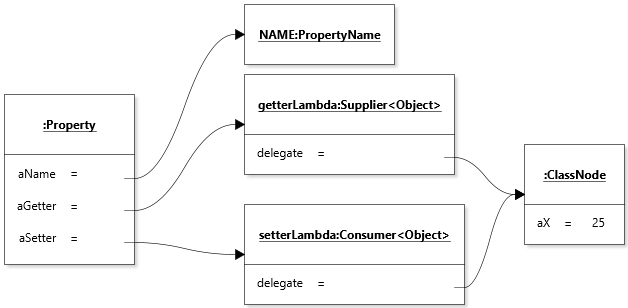Diagram Element Properties
Scope
The Diagram Element Properties feature concerns how the domain-related state of diagram elements (nodes and edges) is captured, initialized, and made available to the rest of the application.
Design
The state of diagram elements (i.e., instances of DiagramElement) can be separated into two categories:
- Application-related state, such as the reference to the diagram that contains them, or the parent or children nodes of hierarchical nodes;
- Domain-related state, which captures the properties of a diagram element that define it intrinsically (e.g., the name of a node, whether a call edge is a signal or not, etc.).
Elements of domain-related state are referred to as properties. Properties are involved in three areas of the application:
- Properties must be obtained and set to persist or retrieve diagrams to/from file storage;
- Properties must be obtained to draw diagrams elements;
- Properties can be viewed and edited explicitly by the user through a
PropertySheet.
Prior to Release 2.0, properties of diagram elements were accessed through the JavaBeans Framework. This was replaced in Release 2.0 with a special-purpose internal property feature because the JavaBeans framework was too heavy and brittle for the relatively simple requirements of JetUML.
The main elements in the design of the properties feature are as follows:

Defining a Property
An instance of Property consists of three pieces of information:
- The name of the property (an enumerated value listed in
PropertyName) - A setter for the property.
- A getter for the property.
The getter and setter are references to objects whose method will obtain (get) or set (accept) the value of the property. These are intended to be supplied through lambda expressions. With this design, a separate object (the property) thus becomes a proxy for a small part of the state of a diagram element. Although technically the getter and setter used to initialize a Property instance could be defined to get and set values on different objects, this is not an intended use: a given property should always get and set values on the same object. The following object diagram shows a Property instance to represent the X-coordinate of a ClassNode.

Property Collections
A collection of Property instances for a given DiagramElement object is aggregated into a Properties object. A Properties object is essentially an order-preserving map between property names and the corresponding Property object, together with a number of convenient methods for creating properties and adding them to the collection. Order is important because other parts of the application (typically the GUI) will want to rely on a predictable iteration order for presenting properties to users. Properties are made available through the properties() method, defined in the DiagramElement interface.
Given the above design, getting and setting the value of a property is done as follows:
ClassNode node = ...
String name = node.properties().get(PropertyName.NAME).get();
node.properties().get(PropertyName.NAME).set(25);
Initializing Properties
Initializing properties is a bit tricky because instances of DiagramElement must be Cloneable, which rules out exclusive constructor-based initialization. The protocol for creating a Properties object for a DiagramElement is thus triggered by a call to buildProperties(), which is called by both the constructor and clone() method of AbstractDiagramElement. The idea is that buildProperties() is overridden by subclasses, which however call super.buildProperties() as the first statement of the method. The call chain thus propagates up to AbstractDiagramElement.buildProperties(), which initializes a fresh (empty) Properties object, and then back down into the method of each subclass, which can then add the properties that correspond to the fields defined in the subclass.
The following code, in class InterfaceNode, illustrates this protocol:
@Override
protected void buildProperties()
{
super.buildProperties();
properties().add(PropertyName.METHODS,
() -> aMethods,
pMethods -> aMethods = (String)pMethods);
}
The super call binds to NamedNode.buildProperties(), which then calls super.buildProperties() and so on. When all superclasses have contributed their properties, control returns to IntefaceNode.buildProperties(), which adds the “methods” property (the text that describes the methods of an interface).